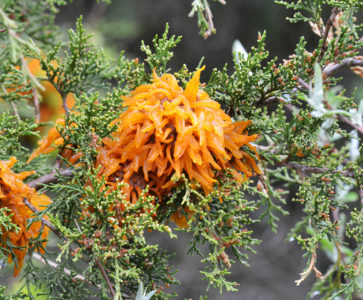Cedar Apple Rust Is A Fungus

The two most common rust diseases are cedar-apple rust and cedar-hawthorn rust. The two conditions have similar effects on trees, but they require a different host species. Cedar apple rust is a fungal disease that spends part of its life cycle on Eastern red cedar (Juniperus virginiana) and the other part on crabapples and hawthorns. Cedars, crabapples, and hawthorns must be within five miles of each other to complete the development of the rust disease.
What Trees & Shrubs Are Affected?
All non-resistant varieties of the following tree and shrubs can be affected by cedar apple rust:
- Apple
- Crabapple (Malus spp.)
- Hawthorns (Crataegus spp.)
- Eastern Red Cedars
- Juniperus Virginiana and other junipers (Juniperus spp.)
What Is The Lifecycle Of Cedar Apple Rust?
The rust fungus begins on juniper species. There it passes one full year of its lifecycle in a gall formed by the tree. In the spring of the second year, the gall opens and exposes the jelly-like, tendril, fruiting structures of the rust organism known as spore horns. Once the spore horns are exposed, they begin to dry out and eventually disperse spores into the air and onto young, newly developing leaves of apples and hawthorns.
Once the fungus has established on the apple or hawthorn, small yellow spots can occur on the leaves. After a few weeks, the spots appear orange or brown with hairlike appendages on the underside of the leaf. In late summer, the spores are released from the apple or hawthorns and drift back to the nearby junipers.
What Are The Symptoms Of Cedar Apple Rust?
On junipers, look for galls on the twigs in July. Jelly-like tendrils will emerge from galls in the spring.
On crabapples and hawthorns, the leaves and fruit will be spotted yellow/orange on the upper surface in late spring. During summer, the spots will enlarge into rust lesions showing through to the lower surface of the leaf. Hairlike structures will appear on the bottom of leaves in midsummer and release spores. Leaves may drop in dry summers. Rust will also appear swelling on the twigs.
Manage Cedar Apple Rust With The Professionals
The best way to avoid problems with rust diseases is to plant resistant varieties of crabapples and hawthorns. Some good choices are:
- Malus Prairifire
- Malus Mary Potter
- Crataegus Laevigata
- Crataegus Viridis Winter King
Eliminate one of the host species in the area. Though this is an effective form of control, it is not very practical.
A fungicide may be applied by a professional from Hansen’s Tree Service as a preventative to help minimize the chance of disease. No chemical application will be effective after the symptoms occur.
